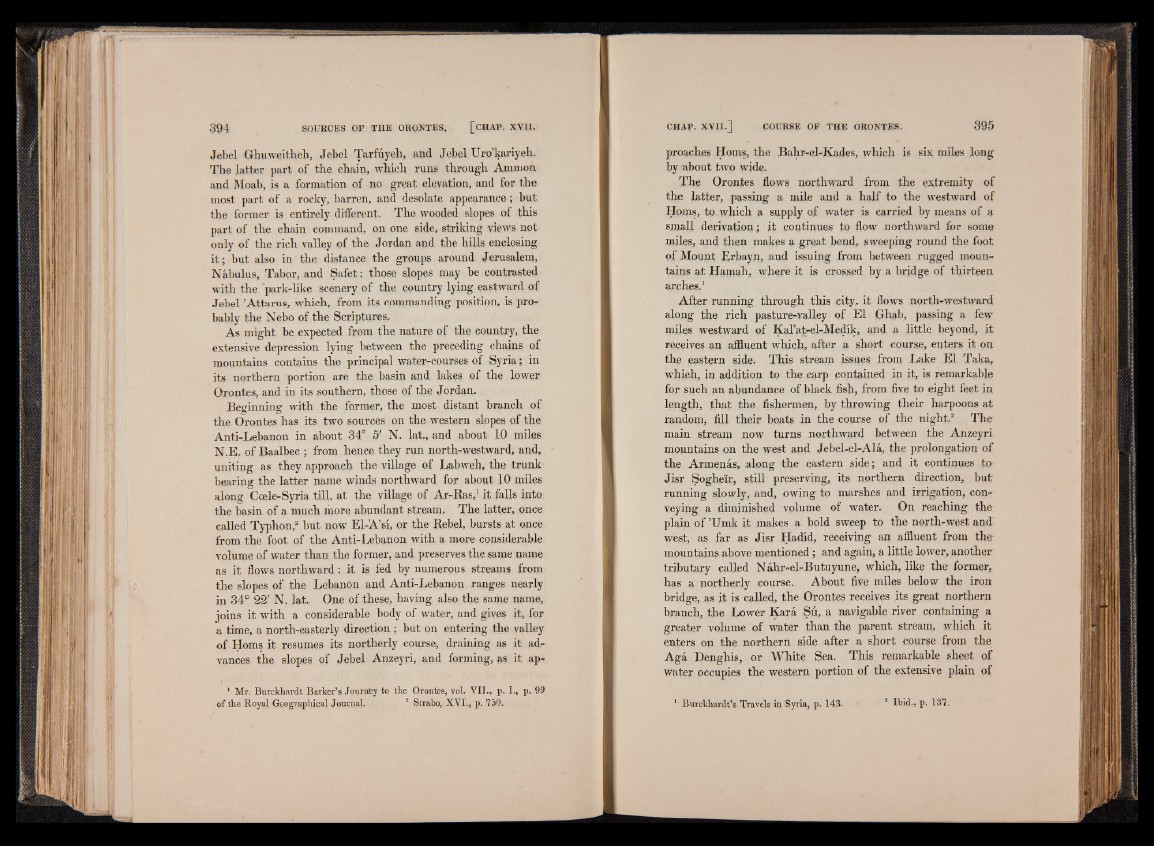
Jebel Ghuweitheh, Jebel Tarfuyeli, and Jebel Uro’kariyeh.
The latter part of the chain, which runs through Ammon
and Moab, is a formation of no great elevation, and for the
most part of a rocky, barren, and desolate appearance; but
the former is entirely different. The wooded slopes of this
part of the chain command, on one side, striking views not
only of the rich valley of the Jordan and the hills enclosing
it; but also in the distance the groups around Jerusalem,
Nabulus, Tabor, and Safet; those slopes may be contrasted
with the 'park-like scenery of the country lying eastward of
Jebel ’Attarus, which, from its commanding position, is probably
the Nebo of the Scriptures,
As might be expected from the nature of the country, the
extensive depression lying between the preceding chains of
mountains contains the principal water-courses of Syria; in
its northern portion are the basin and lakes of the lower
Orontes, and in its southern, those of the Jordan,
Beginning with the former, the most distant branch of
the Orontes has its two sources on the western slopes of the
Anti-Lebanon in about 34° o' N. lat., and about 10 miles
N.E. of Baalbec ; from hence they run north-westward, and,
uniting as they approach the village of Labweh, the trunk
bearing the latter name winds northward for about 10 miles
along Coele-Syria till, at the village of Ar-Bas,1 it falls into
the basin of a much more abundant stream, The latter, once
called Typhon,2 but now Li-A’si, or the Rebel, bursts at once
from the foot of the Anti-Lebanon with a more considerable
volume of water than the former, and preserves the same name
as it flows northward: it is fed by numerous streams from
the slopes of the Lebanon and Anti-Lebanon ranges nearly
in 34° 22' N. lat. One of these, having also the same name,
joins it with a considerable body of water, and gives it, for
a time, a north-easterly direction ; but on entering the valley
of Horns it resumes its northerly course, draining as it advances
the slopes of Jebel Anzeyri, and forming, as it ap1
Mr. Burckhardt Barker’s Journtey to the Orontes, vol. VII., p. I., p. 99
of the Royal Geographical Journal. 2 Strabo, XVI., p. 750.
proaches Horns, the Bahr-el-Kades, which is six miles long
by about two wide.
The Orontes flows northward from the extremity of
the latter, passing a mile and a half to the westward of
iioms, to which a supply of water is carried by means of a
small derivation; it continues to flow northward for some
miles, and then makes a great bend, sweeping round the foot
of Mount Erbayn, and issuing from between rugged mountains
at Hamah, where it is crossed by a bridge of thirteen
arches,1
After running through this city, it flows north-westward
along the rich pasture-valley of El Ghab, passing a few
miles westward of Karat-el-Medik, and a little beyond, it
receives an affluent which, after a short course, enters it on
the eastern side. This stream issues from Lake El Taka,
which, in addition to the carp contained in it, is remarkable
for such an abundance of black fish, from five to eight feet in
length, that the fishermen, by throwing their harpoons at
random, fill their boats in the course of the night,2 The
main stream now turns northward between the Anzeyri
mountains on the west and Jebel-el-Ala, the prolongation of
the Armena.s, along the eastern side; and it continues to
Jisr Sogheir, still preserving, its northern direction, but
running slowly, and, owing to marshes and irrigation, conveying
a diminished volume of water. On reaching the
plain of ’Umk it makes a bold sweep to the north-west and
west, as far as Jisr Ha(lid, receiving an affluent from the-
mountains above mentioned; and again, a little lower, another
tributary called Nahr-el-Butuyune, which, like the former,
has a northerly course. About five miles below the iron
bridge, as it is called, the Orontes receives its great northern
branch, the Lower Kara Su, a navigable river containing a
greater volume of water than the parent stream, which it
enters on the northern side after a short course from the
Aga Denghis, or White Sea. This remarkable sheet of
water occupies the western portion of the extensive plain of
1 Burckhardt’« Travels in Syria, p. 143. 8 Ibid., p. 137.